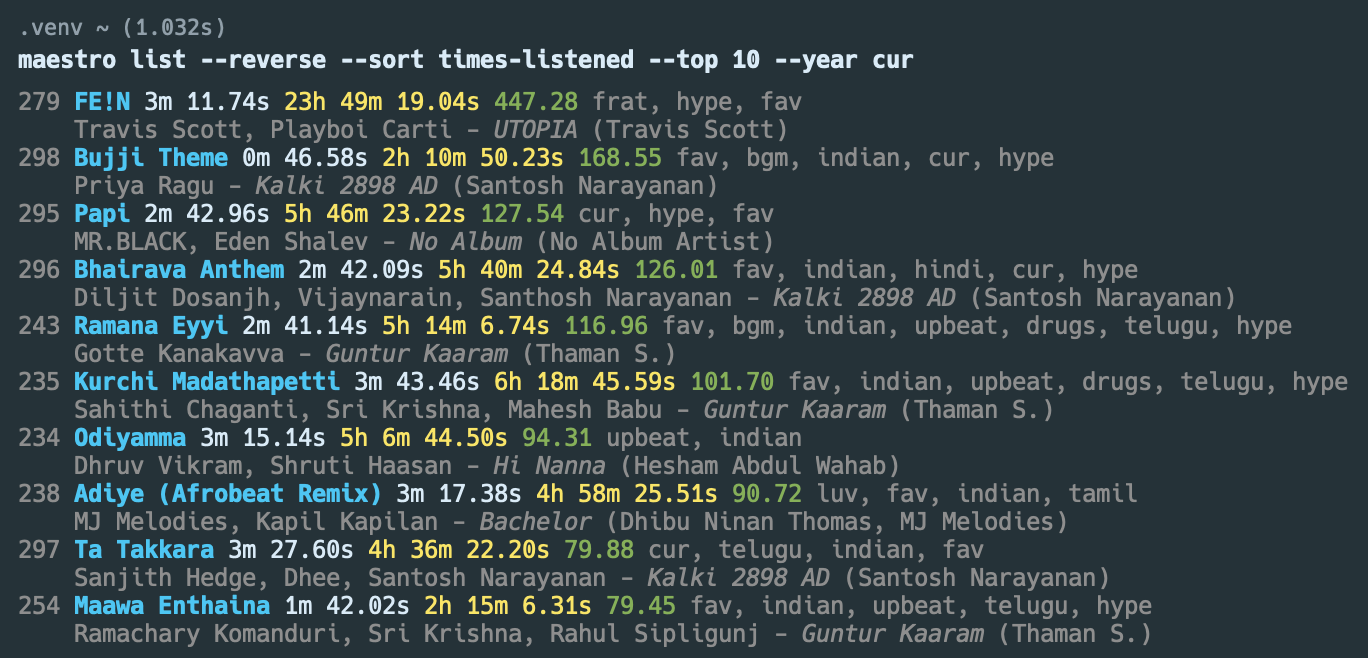A simple command line tool to play songs (or any audio files, really).
Project description
maestro
maestro is a command-line tool to play songs (or any audio, really) in the terminal.
Check out the Discord server!
Features
- cross-platform!
- add songs from YouTube, YouTube Music, or Spotify!
- stream your music!
- lyrics!
- romanize foreign-language lyrics
- translate lyrics
- clips!
- filter by tags!
- listen statistics!
- shuffle! (along with precise control over the behavior of shuffling when repeating)
- audio visualization directly in the terminal!
- Discord integration!
- Now Playing Center integration on macOS! (allows headphone controls)
- music discovery!
Technical Details
Visualization Breakdown Listen-along Streaming Breakdown
Installation
Using pip
Make sure you have Python 3 and pip installed.
First, run
pip install maestro-music
NOTE: pip install maestro and pip install maestro-cli will NOT work, they are totally unrelated PyPI packages.
Now, if you want to be able to directly download songs from YouTube or Spotify, you'll need to install FFmpeg. You can download FFmpeg yourself globally, or locally with maestro download-ffmpeg.
Download executable
Using Python and pip is the preferred way; executables may be slower/have bugs, and pip makes updating way easier. However, the releases page does have executables/installers for macOS, Windows, and Linux.
macOS
Download the .pkg file corresponding to your Mac's architecture; Apple Silicon (M1, M2, M3, etc.) or Intel. Right click on the file in Finder and click "Open" (double clicking won't work). The installation may be a bit slow, and the first run of maestro will probably be slow as well.
Windows
Download and install using maestro-installer.exe.
Linux
Built on Ubuntu; should work on other Linux distros too. Download and unzip maestro-ubuntu.tar.gz. This should unzip a folder named dist, which contains a single folder named maestro. Inside maestro will be another folder, _internal, and two scripts: maestro and install-maestro. Assuming you unzipped inside Downloads, run
cd Downloads/dist/maestro
sudo ./install-maestro
You can then safely delete dist.
Known Issues
If you get a segmentation fault when running maestro play on macOS, it may be caused by an issue with the Python installation that comes bundled with macOS, as Apple uses an old version of ncurses for the curses module. To fix this, you can install Python directly from the Python website, which should fix the issue.
If you have issues on Linux, try sudo apt-get install python3-dev python3-dbus.
Platforms
Tested heavily on macOS, lightly on Windows and (Ubuntu) Linux. maestro was coded to be cross-platform, but if there are any problems, please open an issue (or PR if you know how to fix it!). You can also join the Discord server and ask for help there.
maestro should work on any 3.x version of Python, but I coded it on 3.12 and don't test on earlier versions.
Supports .mp3, .wav, .flac, and .ogg (Ogg Vorbis).
Usage
Run maestro -h to get a list of commands. Run maestro <some command> -h to get comprehensive help for that command—the below is just an overview. Click h in the player session to get a list of commands (scrollable).
maestro uses the concept of a positive integer song ID to uniquely refer to each song; any place where maestro expects a song ID should also allow a search phrase—if only one song matches, maestro will infer the song ID.
Adding Songs
You can add a song from a file or folder with maestro add <PATH>. To add songs in subfolders as well, pass the -R/--recursive flag.
Pass the -Y/--youtube flag to download from a YouTube or YouTube Music URL instead of a file path. This requires FFmpeg. Passing a YouTube Music song URL (not "Video") is recommended, as passing "Video"s (i.e. just normal YouTube videos) can sometimes mess up the artist/album data (this can always be fixed manually with the maestro metadata command, though).
Pass the -S/--spotify flag to download from a Spotify URL instead of a file path. This also requires installing FFmpeg.
Pass the -P or --playlist flag to download an entire YouTube playlist from a song URL with a playlist component, e.g. https://www.youtube.com/watch?v=V1Z586zoeeE&list=PLfSdF_HSSu55q-5p-maISZyr19erpZsTo. The -P flag is unnecessary if the URL points directly to a playlist, e.g. https://www.youtube.com/playlist?list=PLfSdF_HSSu55q-5p-maISZyr19erpZsTo.
By default, maestro add copies the file to its internal database (~/.maestro-files), but you can pass the -M or --move flag to move the file instead. You can also change the folder where the songs are stored with maestro dir.
Tags
Playlists don't exist—maestro uses tags. For example, let's say you want to be able to listen to all your rap songs together. Instead of adding them all to a playlist, run maestro tag <space-separated song IDs for each rap song> -t rap. Then maestro play rap will play all the songs you've added the rap tag to. Basically, if song s has tag t, then you can think of song s as belonging to the playlist defined by tag t. The advantage of tags over playlists is that you can combine tags; maestro play A B will play only songs tagged A or B (add the -M/--match-all flag to play only songs tagged A and B).
Listen Statistics
maestro also tracks your listen time—total and by year. You can see this with maestro list and/or maestro entry. For example, to see your top 10 listened songs this year (by average number of times listened; note that this is NOT the number of times the song was played, but rather the total listen time for that song divided by the duration), run maestro list --reverse --sort times-listened --top 10 --year cur—replace 'cur' with e.g. '2020' to get the listen times for 2020 instead.
Clips
Ever been listening to music, and you're skipping every song because you keep getting bored of them? You like the songs, you're just not in the mood to listen to all of them entirely.
Introducing clips, something I've always wished the big companies like Spotify and YouTube Music would do. Use maestro clip <song ID> <START> <END> to define a clip for any song with a start and end timestamp (or use the clip editor for fine-grained control with maestro clip <song ID>), then maestro play -C to play in "clip mode" (can also be toggled in the player session with the c key)—this will play the clips for each song (or the entire song if there's no clip). Now you can listen to only the best parts of your music!
By default, maestro clip creates a clip named 'default'; you can add additional clips with the --name option:
maestro clip <song ID> --name clip1
maestro set-clip <song ID> clip1
The maestro set-clip command will set 'clip1' as the clip to be played in clip mode instead of 'default'.
Lyrics
maestro add will automatically attempt to download lyrics (synced if possible) for the song. You can romanize foreign-language lyrics with maestro translit <song ID> --save, which will save the romanization as an override .lrc file (the original lyrics will still be preserved in the metadata of the song's file, but the override will be used). You can add a translation for a song with maestro translate <song ID> --save, which can then be shown with the lyrics using maestro play --lyrics --translated-lyrics. Not passing --save to either command will print the lyrics instead of saving them.
Press y in the player session to toggle lyrics, t to toggle translated lyrics. To scroll through lyrics, change focus to the lyrics window with } (you can change focus back to the queue with {).
Shuffling
maestro play accepts two shuffle options, -s/--shuffle and -r/--reshuffle. The first is for shuffling the song before the player session starts, and the second is for reshuffling the queue when it loops (the -r option is ignored if you don't also pass the -L/--loop flag to loop the queue). The default for both is 0, i.e. no shuffling. To shuffle completely randomly, pass -1; otherwise, passing any positive integer n will ensure that each song is no more than n positions away in the queue from its previous position.
Visualization
Run maestro play --visualize or click v in the player session to show the visualizer.
Discord Status
Run maestro play --discord or click d in the player session to show the currently playing song in your Discord status (requires the Discord app to be open). Hovering over the image will show the album name. To show album art, requires signing up/logging in with maestro signup/maestro login.

Streaming
If you're logged in as user123, run maestro play --stream (or click s in the player session) to stream your music to maestro-music.vercel.app/listen-along/user123. This will show up as a "Listen Along" button on your Discord status too, if the Discord status is enabled (some versions of the Discord app don't show buttons on your own status, but it should show for everyone else).
Music Discovery
Use maestro recommend <song ID> to recommend similar songs (searches up the song name on YouTube Music).
Project details
Release history Release notifications | RSS feed
Download files
Download the file for your platform. If you're not sure which to choose, learn more about installing packages.
Source Distribution
Built Distribution
File details
Details for the file maestro_music-2.0.3.tar.gz.
File metadata
- Download URL: maestro_music-2.0.3.tar.gz
- Upload date:
- Size: 99.6 kB
- Tags: Source
- Uploaded using Trusted Publishing? No
- Uploaded via: twine/3.8.0 pkginfo/1.9.6 readme-renderer/40.0 requests/2.32.3 requests-toolbelt/1.0.0 urllib3/2.2.2 tqdm/4.65.0 importlib-metadata/8.2.0 keyring/25.2.1 rfc3986/1.5.0 colorama/0.4.6 CPython/3.11.9
File hashes
| Algorithm | Hash digest | |
|---|---|---|
| SHA256 | 16fe43e27b49aed5935babbcdf5bec20a47b5c749a572bbb5ea02fd2bf1464cd |
|
| MD5 | 9c32b966c95d06fb90e2eb8b4e75de6e |
|
| BLAKE2b-256 | 8433bf8576f2cc58665ced08431e78380268bca1470987f131edc1ffefa56356 |
File details
Details for the file maestro_music-2.0.3-py3-none-any.whl.
File metadata
- Download URL: maestro_music-2.0.3-py3-none-any.whl
- Upload date:
- Size: 97.7 kB
- Tags: Python 3
- Uploaded using Trusted Publishing? No
- Uploaded via: twine/3.8.0 pkginfo/1.9.6 readme-renderer/40.0 requests/2.32.3 requests-toolbelt/1.0.0 urllib3/2.2.2 tqdm/4.65.0 importlib-metadata/8.2.0 keyring/25.2.1 rfc3986/1.5.0 colorama/0.4.6 CPython/3.11.9
File hashes
| Algorithm | Hash digest | |
|---|---|---|
| SHA256 | d0b1add4b7f33fbc86788fbcde333c10a9b9015702f961c8e860d4b8f0c38792 |
|
| MD5 | 8c18d3932dc262df3607b1a97c5897d2 |
|
| BLAKE2b-256 | d38c51e6ae813d27d80f7dc81bcf84b27a55806f839b954b2c7ffd93bd07ede9 |


















